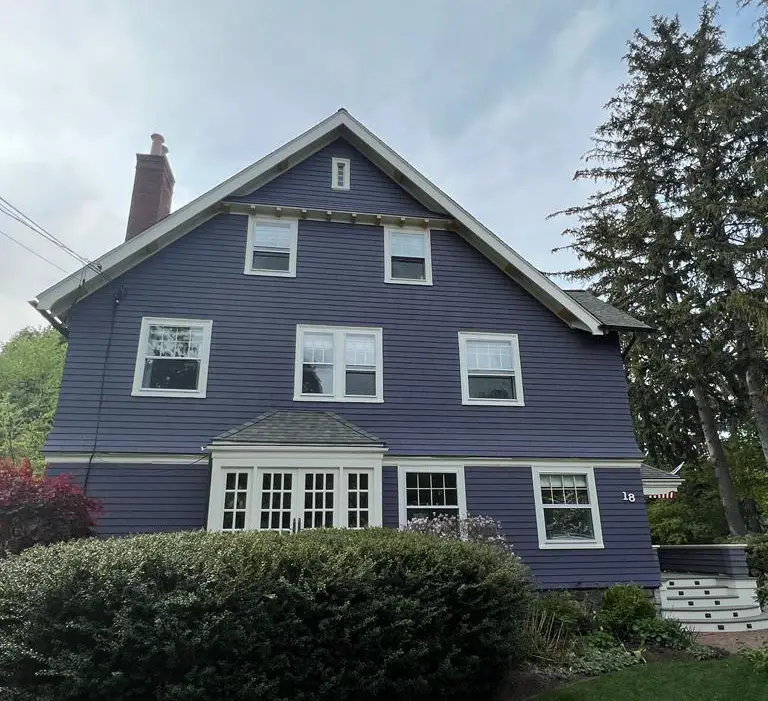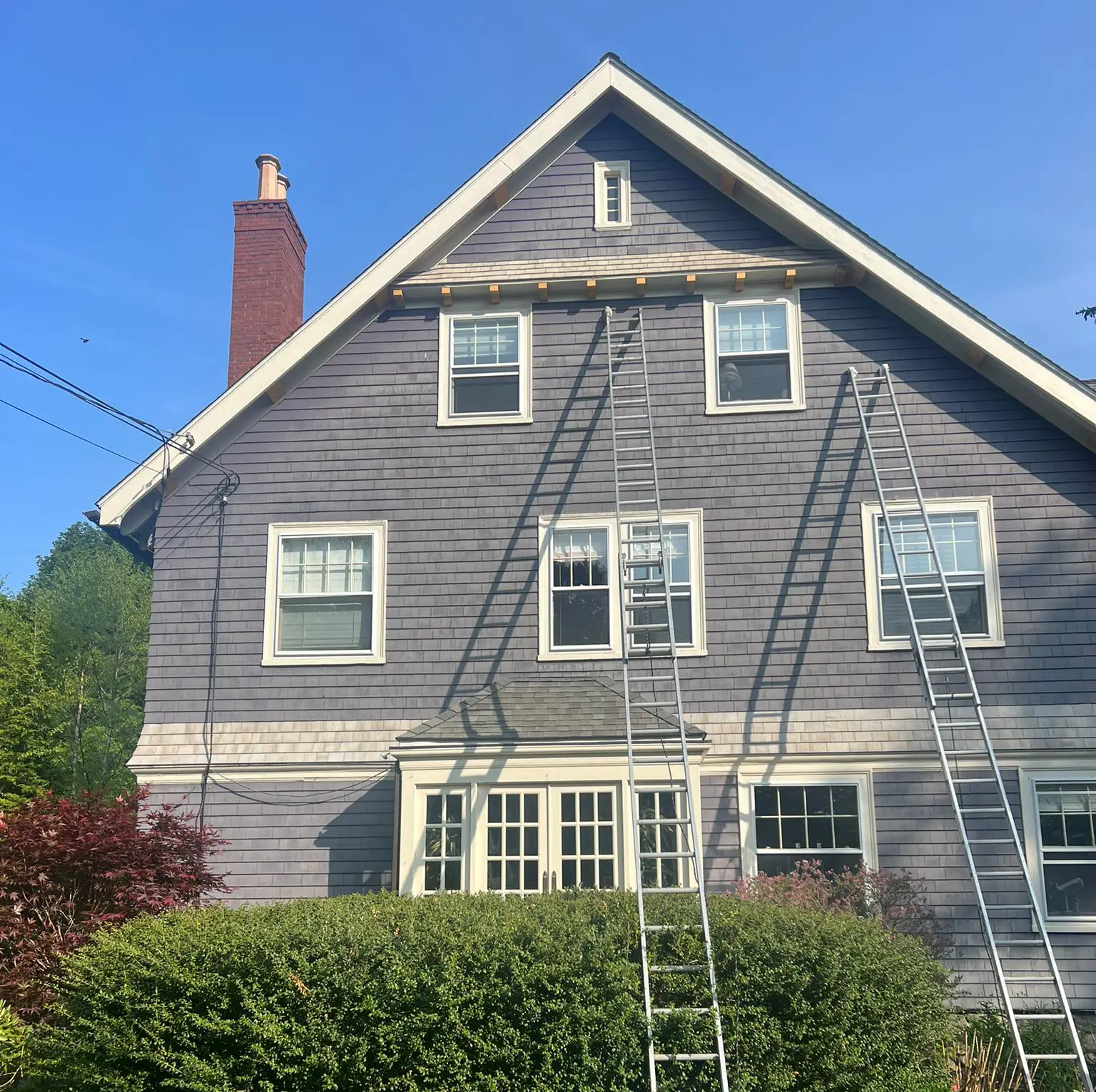Blogs

Vinyl Siding Painting | Before & After Results & Tips
Vinyl siding is a popular choice for its durability and low maintenance, often touted as a "never paint again" solution. However, over years of sun exposure and weathering, even the best vinyl can fade, show chalking, or simply fall out of favor with your evolving design preferences. When this happens, homeowners often face a dilemma: replace the siding entirely or explore painting it? The exciting news is that painting vinyl siding is not only possible but can deliver stunning "before and after" transformations, giving your home a fresh, vibrant look for a fraction of the cost of replacement. Masterpiece Painter details what to expect and how to achieve real results when painting vinyl siding.
Why homeowners repaint vinyl siding
Homeowners choose to repaint their vinyl siding for a variety of compelling reasons, driven by both aesthetics and practicality:
Faded and Dull Appearance: This is the most common reason. UV rays from the sun can break down the pigments in vinyl over time, leading to a washed-out, chalky, or unevenly faded appearance that diminishes curb appeal.
Outdated Color Scheme: Home design trends evolve. The beige or light gray that was popular two decades ago might now feel bland or dated. Painting offers a complete color overhaul to match contemporary styles or your personal aesthetic.
Minor Blemishes and Scuffs: While vinyl is durable, it's not impervious to minor scuffs, scratches, or stubborn stains that simple washing won't remove. Paint can effectively conceal these imperfections, providing a uniform and fresh surface.
Cost-Effectiveness: Replacing vinyl siding is a major investment. Painting offers a significantly more affordable way to dramatically improve your home's exterior appearance, making it an excellent option when budget is a primary concern.
Boosting Curb Appeal for Resale: A fresh, modern exterior is a huge selling point. Painting can quickly increase your home's attractiveness to potential buyers, potentially boosting its market value.
Unified Look: If you've updated other exterior elements (like new windows or a new roof) and the existing vinyl color clashes, painting allows you to create a cohesive and harmonious exterior design.
Preparation steps before painting
The success of painting vinyl siding hinges almost entirely on meticulous preparation. Skipping or rushing these steps will lead to poor adhesion and premature paint failure.
Inspect and Repair: Walk around your entire house, closely inspecting the vinyl siding.
Repair Damage: Address any loose panels, significant cracks, holes, or warped sections. Small holes can be patched with vinyl repair kits, but severely damaged or warped panels should be replaced before painting, as paint won't fix structural issues.
Secure Loose Panels: Ensure all panels are securely fastened to prevent movement and potential cracking of the paint film later.
Thorough Cleaning (Absolutely Crucial!): This is the most vital step. Vinyl siding accumulates dirt, grime, mildew, and a chalky residue (oxidation) over time. All of this must be removed for paint to adhere properly.
Pre-Rinse: Start with a good rinse using a garden hose or a low-pressure setting on a power washer (be careful not to force water behind panels or damage the vinyl).
Wash with Detergent: Use a mild household detergent (like dish soap) mixed with water, or a specialized vinyl siding cleaner. For stubborn mildew or mold, use a solution of 1 part bleach to 3 parts water (or an oxygen-bleach cleaner). Apply the solution with a soft-bristled brush or a soft-bristled broom extension, working from the bottom up to avoid streaking.
Scrub Thoroughly: Pay close attention to textured areas and shaded spots where mold and mildew thrive.
Rinse Meticulously: Rinse the entire house from top to bottom with clean water until all soap residue, bleach, and cleaning agents are completely gone. Any residue will interfere with paint adhesion.
Allow to Dry Completely: The siding must be bone dry before you apply any paint. This usually takes 24 to 48 hours of dry, non-humid weather. Do not proceed if there's any dampness.
Remove & Mask Obstructions:
Carefully remove shutters, light fixtures, downspouts, mailboxes, and any other attachments. Label them for easy reinstallation.
Use high-quality painter's tape to meticulously mask off all areas you don't want painted: windows, doors, trim (if painting a contrasting color), foundation, light fixtures you couldn't remove, and any adjacent brick or stone. Press the tape down firmly to ensure crisp lines.
Lay down drop cloths or plastic sheeting to protect landscaping, patios, and walkways from overspray or drips.
Paint types and colors that work on vinyl
Choosing the right paint is paramount to avoid vinyl warping and ensure a lasting finish.
Paint Type: You must use 100% Acrylic Latex Exterior Paint. Acrylic paints are flexible, allowing them to expand and contract with the vinyl siding as temperatures change, which prevents cracking and peeling. They also offer excellent adhesion and durability for exterior exposure.
"Vinyl-Safe" / "Cool Color Technology": This is the most crucial consideration for color choice. Older vinyl siding paints and traditional dark colors absorbed excessive heat from the sun, causing the vinyl to buckle, warp, and sag.
Modern "vinyl-safe" paints contain special heat-reflective pigments that keep the siding cooler by reflecting infrared light. This innovation allows homeowners to safely choose darker, more vibrant colors than the original siding.
Always check the paint can label for this specific designation. If a paint doesn't explicitly state "vinyl-safe" or "for use on vinyl," stick to colors that are lighter than or similar in lightness to the original vinyl to minimize heat absorption risks.
Sheen: Satin or eggshell finishes are generally recommended. They offer a subtle sheen that helps hide minor imperfections, are easier to clean, and provide good durability. Flat finishes can absorb more dirt, while high-gloss can highlight every flaw.
Primer (Often Optional): Many quality "vinyl-safe" acrylic paints are self-priming. However, for heavily faded, chalky, or stained vinyl, a dedicated acrylic primer (also compatible with vinyl) can offer extra adhesion and help create a more uniform base color.
Before and after examples
While we can't show literal images, imagine the transformation through these common scenarios:

Before: A suburban home with pale, faded yellow vinyl siding. It looks tired, uninspired, and blends into the background. The color appears uneven due to years of sun exposure.
After: The same home, now painted a sophisticated deep slate blue, with crisp white trim around the windows and doors. The previously drab exterior now boasts striking contrast, a modern aesthetic, and undeniable curb appeal. The house appears more substantial and well-maintained.

Before: A farmhouse-style home with white vinyl siding that has become chalky and dingy, marred by some scuffs and mildew spots that won't entirely wash off.
After: The home is now painted a warm, inviting sage green, with a deeper cream color on the trim. The transformation is remarkable; the house now feels more integrated with its natural surroundings, exuding a welcoming, refreshed charm. The paint has provided a uniform, clean surface, erasing the old blemishes.

Before: A contemporary home with a standard light beige vinyl that feels uninspired and doesn't showcase its modern lines.
After: The house is transformed with a sleek, dark charcoal gray vinyl paint. This bold choice enhances the architectural elements, giving the home a sophisticated and updated modern presence that truly stands out. The texture of the vinyl is now more pronounced, adding depth.
These transformations demonstrate how a fresh coat of specialized paint can take your home from "blah" to "wow," often surprising homeowners with the dramatic impact it has on the property's overall presentation.
How long the paint job lasts
The longevity of paint on vinyl siding depends on several factors:
Preparation Quality: Excellent surface prep is the biggest determinant. A rushed or incomplete cleaning and repair job will significantly shorten the paint's lifespan.
Paint Quality: Investing in premium 100% acrylic "vinyl-safe" paint is crucial. Cheaper paints will fade, chalk, and peel much faster.
Application Technique: Thin, even coats applied in optimal weather conditions will adhere better and last longer.
Sun Exposure: Siding facing direct, prolonged sunlight (especially south-facing walls) will experience more wear and tear and may fade faster than shaded areas.
Environmental Conditions: Harsh climates with extreme temperature fluctuations, heavy rain, or strong UV can reduce longevity.
With proper preparation and high-quality "vinyl-safe" acrylic paint, you can realistically expect your paint job to last 7 to 15 years, with some premium jobs potentially reaching closer to 20 years before needing a refresh. This is a significant lifespan for a painted exterior surface.
Costs vs Benefits compared to replacement
Deciding whether to paint or replace vinyl siding is a major decision with distinct cost-benefit analyses.
Painting vinyl siding:
Costs: Significantly more affordable. Typically 1/3 to 1/5 the cost of replacement. Expect to pay around $1.50 to $4.50 per square foot for materials and professional labor for a paint job (or just material if DIY).
Benefits:
High ROI for Aesthetics: Excellent return on investment for visual appeal and curb appeal enhancement.
Fast Transformation: Quicker project completion than full siding replacement.
Color Flexibility: Allows for a complete change in aesthetic.
Less Waste: Generates less construction waste.
Considerations:
Does Not Fix Major Damage: Only addresses cosmetic issues.
Shorter Lifespan: A paint job won't last as long as brand new siding.
Voids Warranty: Often voids the original vinyl siding manufacturer's warranty.
Replacing vinyl siding:
Costs: Much higher. Typically $3.00 to $12.00+ per square foot installed, depending on siding quality and complexity.
Benefits:
Maximum Longevity: New siding offers 20-40+ years of life.
Improved Energy Efficiency: Opportunity to add new insulation or install insulated vinyl siding.
Structural Repair: Allows for repair of underlying sheathing or wall issues.
New Warranty: Comes with a full manufacturer's warranty.
Highest ROI for Long-Term Value: Can significantly boost home value, especially if old siding was severely damaged or outdated.
Considerations:
Significant Investment: Requires a larger upfront budget.
More Disruptive: Longer project timeline, more extensive waste generated.
Masterpiece Painter's Advice: If your vinyl siding is structurally sound and you primarily want a fresh look, updated color, or to cover minor blemishes, painting is an incredibly cost-effective and rewarding solution. However, if your siding is brittle, cracked in multiple places, severely warped, or if you're looking to significantly upgrade your home's insulation and long-term durability, replacement is likely the better long-term investment.
Painting vinyl siding can indeed produce impressive "before and after" results, transforming a tired exterior into a vibrant and inviting facade. With the right preparation, specialized paints, and meticulous application, you can enjoy a beautifully refreshed home for years. For a guaranteed professional finish and expert guidance on whether painting or replacing is best for your home, trust the experienced team at Masterpiece Painter.
Ready to see a stunning "before and after" transformation for your home's exterior? Contact Masterpiece Painter today for a consultation and a detailed quote to bring your vision to life!
About Masterpiece Painter
For over 17 years Masterpiece Painter, has been serving communities all around New England. Let us help you make your wishes come true by turning your property into a Masterpiece
Get a Quote

© copyright 2023 All Rights Reserved.



